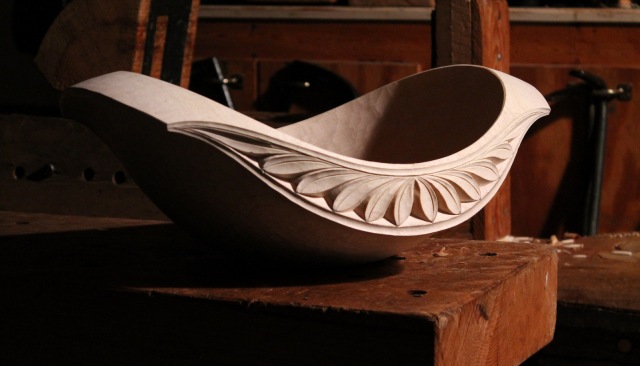A few months ago, I wrote a post about laying out the side panels on this red maple bowl. Since then, the bowl dried and I carved over the surfaces again with paring cuts. By the way, calling this “soft maple” is a dirty trick. They should just call it “softer than hard maple.” Regardless, the surface is creamy white with a very subtle close grain; an ideal canvas for some decorative carving and color.
So, what to carve on the side panel? I wanted to incorporate leaves and I also wanted to take advantage of the potential depth of carving possible in the thicker lower portion of the panel. I scribbled lots of ideas, and refined some of them a bit. It’s also important to keep in mind the ultimate application of the idea; it must be carved on the side panel of a bowl. Perhaps it can be drawn, but can it be carved? I try to imagine how the carving tools can be manipulated. Would I have to go against the grain there? Will an area of the carving be too fragile to be handled? I also wanted to design something that was in harmony with the sinuous shape of the side panel itself. Some designs that might work well between parallel lines don’t adapt well to other forms.
To make a long story short, I came up with this leaf motif. I sketched it directly onto the side panel. Paper patterns and such don’t work well on an undulating surface. Besides, a little natural variation resulting from the hand sketching is interesting. Before I started carving, I even scribbled on some color with some colored pencils just to visualize some possibilities for the eventual painting. That is a whole other matter.
This bowl was a challenge to hold for the side panel carving, at 6 1/2 inches high, 17 1/2 inches long, and 12 inches wide, it was too much bulk to fit in my vise. But a peg and a couple of holdfasts did the trick. A wooden peg under the bowl is padded with a t-shirt, and two holdfasts press the bowl against the apron of the bench. Rubber belting material kept things from slipping around. These holdfasts have a long reach. I mentioned the making of them here a while back.
So now I will be thinking about color for this bowl. I enjoyed talking with Jogge Sundquist about paints a couple months ago. His fearless use of color is inspiring, and his knowledge of paints and traditions is deep. I’ve also been inspired by the work of Bengt Lidström. I’ve mentioned him before, and I am planning to discuss more about him in an upcoming post.




Beautiful work. Its always a pleasure to see these. Thank you!
LikeLike
Your work is so beautiful and this latest bowl is divine. Hubby is so enthralled with your work as well. Do you sell your work? I would truly love to own one of your beautiful bowls.
LikeLike
An exquisite piece of art there David. The decorative motif is totally in harmony with the movement of the bowl – and, as ever – your posts are a joy to read. Thank you for sharing your skill with us.
LikeLike
How would you compare the difficulty in carving the red maple to cherry or oak? My neighbor also took out a red maple and I harvested some chunks for bowl carving. While I am thrilled with the results so far for my first attempt at bowl carving, I am not sure if choosing maple was wise for a first bowl.
LikeLike
Jonathan, I’m glad to hear your first attempts are going well. White oak requires the most force, especially once it is dry. The red maple is similar in hardness to cherry, maybe a little harder. If you can get your hands on some tulip poplar or something similar, you will find the carving easier. Keep in mind that the difference between green and dry is bigger than the difference between species in terms of hardness. Remove all you can while the wood is still green and don’t be shy about it. Leave just enough to clean up the surfaces.
LikeLike
Thanks, Dave. It’s possible that I let the blank dry out a bit too much before I started carving. I’ll make sure I keep an eye on that on the next bowl. I can’t wait to get started on another one while this one dries. I can see getting hooked on this pretty easily!
LikeLike
Pingback: Painted Bowl | David Fisher, Carving Explorations
Impressive. Country Workshops have a very good, long video on Bengt Lidström on youtube – I was surprised by how different his approach is to mine. He has his own distinct approach.
The Grinling Gibbons (Britain’s most famous carver) documentary will be shown again in the UK next week (Wednesday on BBC4 I think?). I watched the preceding episode, on Thomas Chippendale (English furniture maker), last night – his grave is under the National Portrait Gallery now apparently, near Nelson’s column; his workshop was nearby.
LikeLike
For those not in the UK, perhaps you can view it on youtube (in 4 parts): https://www.youtube.com/watch?v=TaUCOXBI4m8
😉
LikeLike